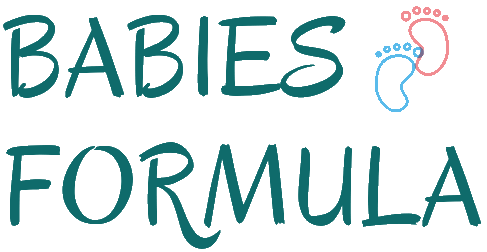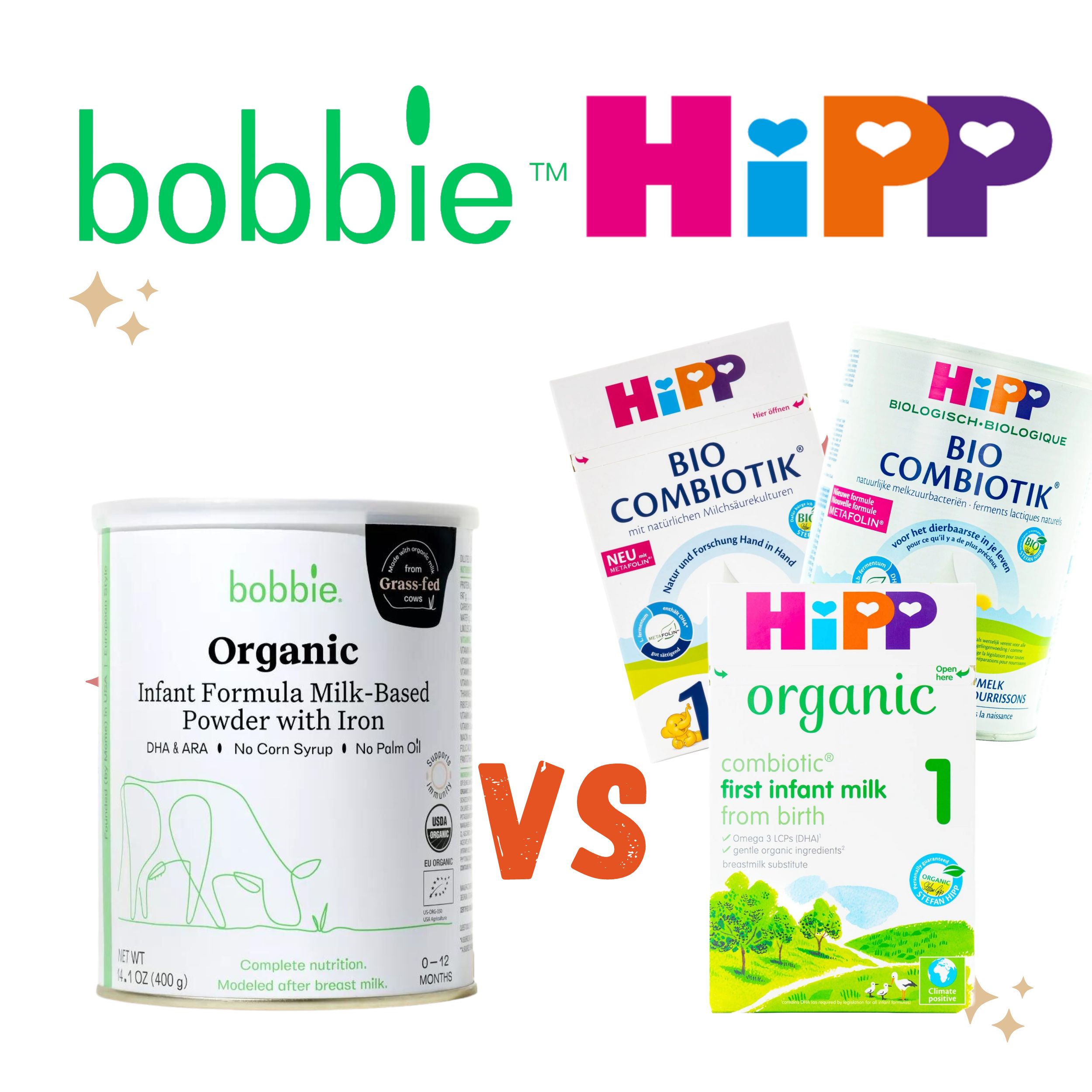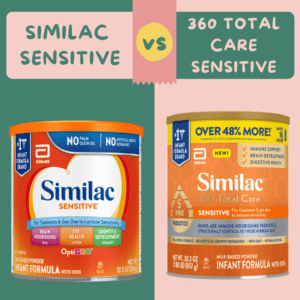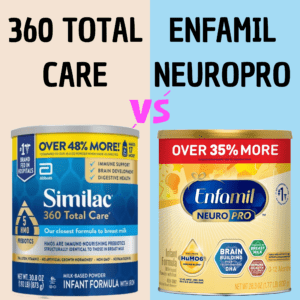HiPP formula uses a stage system in the first year; each age range has a specific formula whereas Bobbie has one formula for the first year. Thus, in this article, we will see a comparison between HiPP and Bobbie for 0-6 months and 6-12 months.
Comparison Chart (0-6 months):
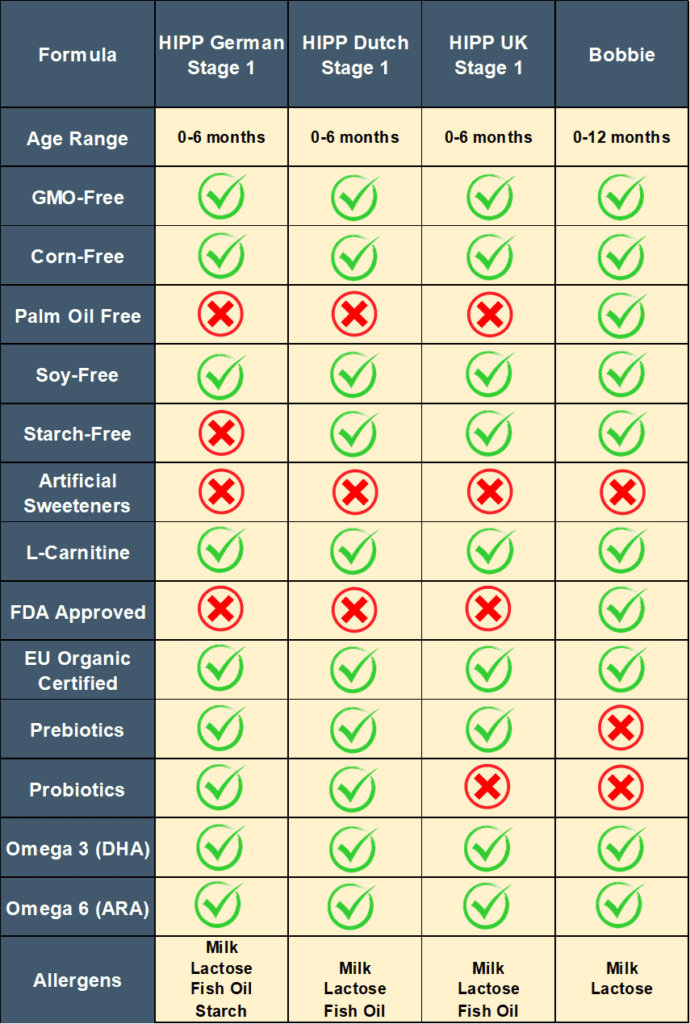
“When you buy something using my links, I may earn a small commission at no additional cost to you. This is a kind of support to me. This website doesn’t accept money for reviews. “
When comparing Bobbie and HiPP infant formulas for ages 0-6 months, several key differences and similarities emerge:
- GMO-Free:
- Both Bobbie and HiPP formulas are GMO-free, which means they do not contain genetically modified organisms, aligning with parents’ preferences for natural ingredients.
- Corn-Free, Starch-Free, and Soy-Free:
- Bobbie stands out by being corn-free, starch-free, and soy-free, making it suitable for infants with specific dietary sensitivities. HiPP is also soy-free and generally starch-free (except for the German version), catering to a broader range of dietary needs.
- Palm Oil:
- Bobbie is palm oil-free, while HiPP formulas are not. The absence of palm oil in Bobbie may be preferable to some parents concerned about sustainability and environmental issues.
- Organic Ingredients:
- Both brands use organic ingredients that are EU organic certified, ensuring a higher standard of ingredient quality and environmentally friendly farming practices.
- Prebiotics and Probiotics:
- HiPP formulas typically include prebiotics and probiotics, which can promote infant gut health, with the exception of the UK version. Bobbie, in contrast, does not include prebiotics or probiotics in its formula. Parents may choose based on their preference for these added components.
- DHA/ARA:
- Both Bobbie and HiPP include DHA (Docosahexaenoic Acid) and ARA (Arachidonic Acid), essential fatty acids important for infant brain and eye development, providing a similar level of nutritional support.
- FDA Requirements:
- Bobbie meets the FDA requirements, making it compliant with U.S. regulatory standards. HiPP, while widely trusted in Europe, may not meet these specific U.S. guidelines, which could be a consideration for some parents.
Related: HiPP VS Holle: Which One is The Best?
Ingredients Comparison (0-6 months):
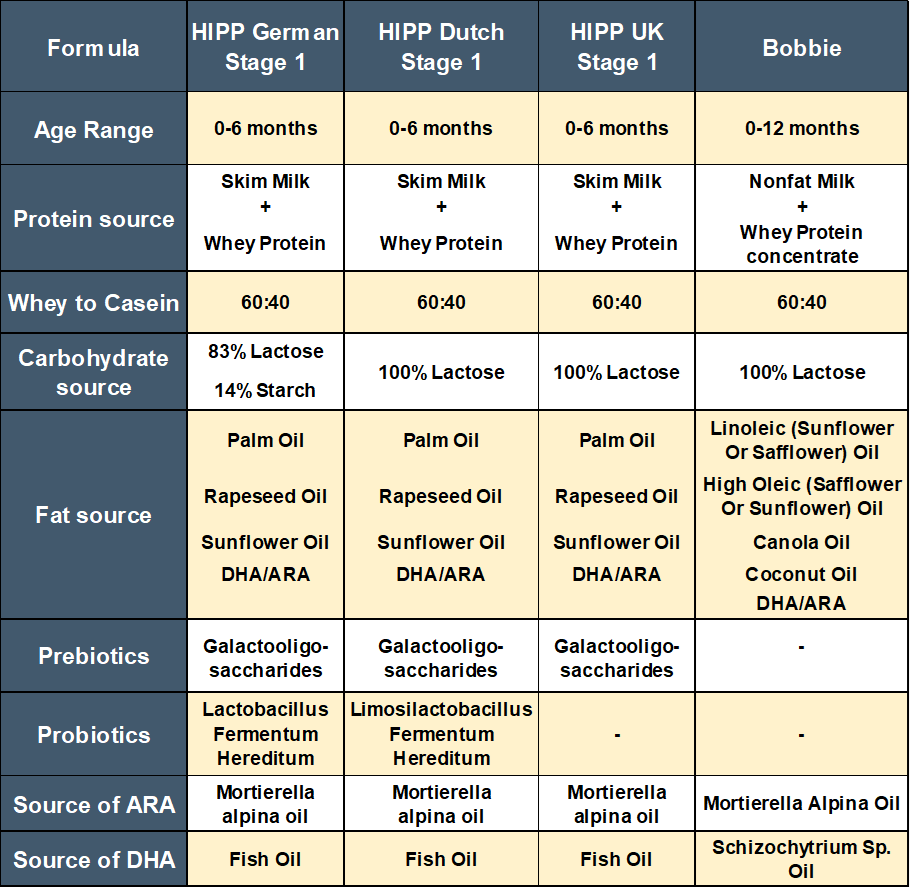
Protein Source:
Bobbie and HiPP (0-6 months) infant formulas share similar protein sources, with both using a combination of skim milk (nonfat milk) and whey protein, and both having a whey-to-casein ratio of 60:40. This whey-dominant ratio closely mimics the composition of breast milk, making both formulas suitable for infants’ delicate digestive systems.
In terms of protein, these formulas provide a balanced and easily digestible source of essential nutrients, contributing to healthy growth and development during the first six months of life.
Related: HiPP Organic Formula VS Enfamil Infant: Which One is The Best?
Carbohydrate Source:
Bobbie and HiPP (0-6 months) infant formulas both predominantly use organic lactose as a carbohydrate source, which closely resembles the carbohydrate composition of breast milk. Lactose is a natural sugar found in breast milk and is easily digestible by most infants. This choice aligns with the goal of providing optimal nutrition for infants.
However, it’s worth noting that the German version of HiPP includes both lactose and starch as carbohydrate sources. The addition of starch may provide additional energy but is not in line with the pure lactose composition found in breast milk or in the non-German versions of HiPP.

Fat Source:
Bobbie and HiPP (0-6 months) infant formulas differ in their sources of fats.
Bobbie uses a blend of organic oils, including high oleic safflower or sunflower oil, linoleic safflower or sunflower oil, canola oil, and coconut oil. These oils offer a diverse range of fatty acids and provide a mix of nutrients, contributing to a well-rounded fat profile in the formula.
On the other hand, all HiPP formulas, regardless of the country of origin, primarily contain a combination of organic palm oil, rapeseed oil, and sunflower oil as their sources of fat. While these oils are organic, it’s important to note that some parents have concerns about the environmental and health implications of palm oil production.
Related: HiPP German Vs Dutch Vs UK: What’s The Difference?
Prebiotics and Probiotics:
Bobbie and HiPP (0-6 months) infant formulas differ significantly in terms of prebiotics and probiotics:
HiPP:
- HiPP formulas include the prebiotic galactooligosaccharides (GOS), which can help support a healthy gut microbiome in infants. GOS is known for promoting the growth of beneficial gut bacteria.
- HiPP also contains a probiotic strain called L. Fermentum, which is a live beneficial bacterium that can further contribute to gut health by aiding digestion and strengthening the immune system.
Bobbie:
- In contrast, Bobbie infant formula does not contain any probiotics or prebiotics. It does not include specific ingredients aimed at fostering the growth of beneficial gut bacteria or directly supporting digestive health.
Nutrient Comparison (0-6 months):
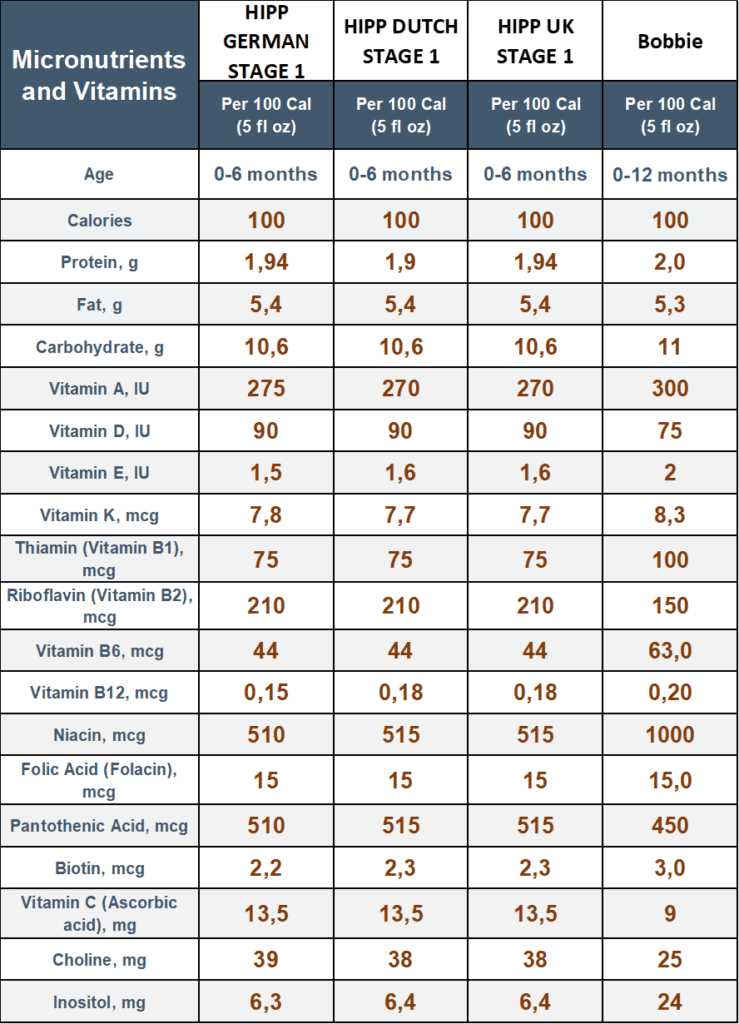
Micronutrients:
In comparing Bobbie and HiPP (0-6 months) infant formulas, considering Bobbie’s relatively higher levels of protein and carbohydrates and HiPP’s slightly higher fat content, it’s important to note that both formulas are designed to provide comprehensive nutrition for infants.
- Protein and Carbohydrates (Bobbie):
- Bobbie’s formulas offer higher levels of protein and carbohydrates, which can be beneficial for infants with specific nutritional needs or preferences for more protein and energy in their diet.
- These increased levels may provide infants with extra energy for growth and development, but it’s essential to ensure they align with an individual infant’s dietary requirements.
- Fat (HiPP):
- HiPP formulas have slightly higher fat content, which is a valuable source of essential fatty acids necessary for brain and eye development in infants.
- The slightly elevated fat content may support the overall energy needs of infants and contribute to their healthy growth.
Related: Holle Vs Bobbie: Which One is Right For Your Baby?
Vitamins:
When comparing Bobbie and HiPP (0-6 months) formulas in terms of vitamins, it’s essential to consider the variations in specific vitamins they offer:
Bobbie:
- Bobbie formulas have higher levels of vitamin A, vitamin E, vitamin K, vitamin B1, vitamin B6, vitamin B12, niacin, biotin, and inositol. These vitamins play essential roles in various aspects of infant development and overall health.
HiPP:
- HiPP formulas, on the other hand, contain higher amounts of vitamin D, vitamin B2, vitamin C, pantothenic acid (vitamin B5), and choline. Vitamin D is crucial for calcium absorption and bone health, while vitamin B2, vitamin C, pantothenic acid, and choline are important for various metabolic processes and overall immune support.
Related: HiPP Combiotic VS Similac Advance & Pro Advance: Which One is The Best?
Minerals:
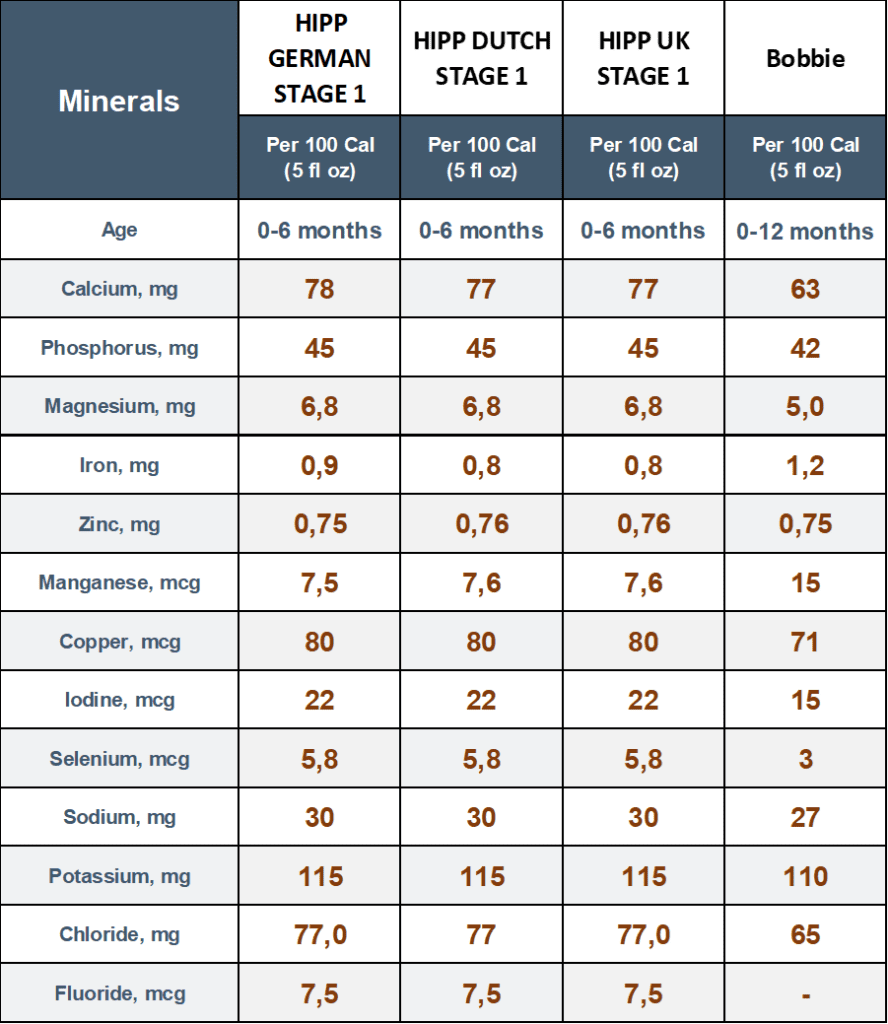
Comparing Bobbie and HiPP (0-6 months) formulas in terms of minerals reveals differences in their mineral compositions:
Bobbie:
- Bobbie formulas contain higher levels of iron and manganese, both of which are essential minerals for infant growth and development, particularly in the formation of red blood cells and overall metabolic processes.
HiPP:
- HiPP formulas have higher levels of calcium, phosphorus, magnesium, copper, iodine, sodium, selenium, potassium, and chloride. These minerals play vital roles in bone and teeth development, nerve function, electrolyte balance, and overall body function.
- HiPP also includes fluoride, which can support dental health but is typically not present in infant formulas due to potential overdose concerns.
Price Comparison (0-6 months):
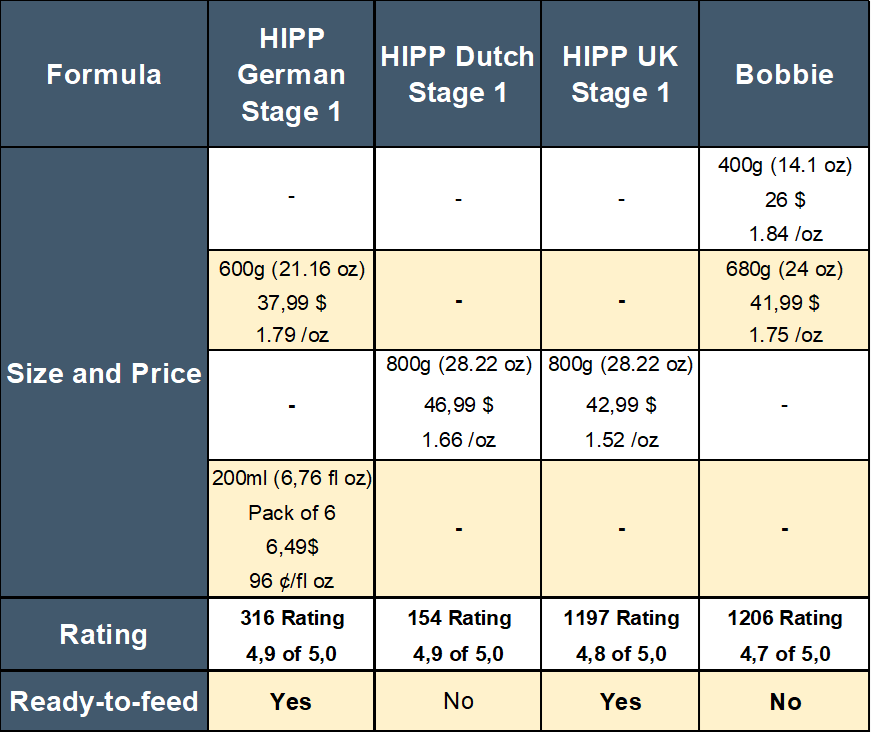
When comparing the prices of Bobbie and HiPP (0-6 months) infant formulas, it’s evident that pricing varies based on the formula size and brand.
Bobbie offers two sizes, 14.1 oz and 24 oz, priced at $26 (approximately $1.84/oz) and $41.99 (approximately $1.75/oz), respectively.
HiPP German formula comes in a 21.16 oz size, priced at $37.99 (approximately $1.79/oz). Additionally, it offers a ready-to-feed version in a 200 ml size (6.76 fl oz) at a cost of approximately 96 cents per fluid ounce.
Meanwhile, HiPP Dutch and UK versions are larger, at 28.22 oz, with prices of $46.99 (approximately $1.66/oz) and $42.99 (approximately $1.52/oz), respectively.
Where to Buy?
| Formula | Where to Buy? |
|---|---|
| HiPP German Stage 1 | Buy HERE |
| HiPP German PRE RTF | Buy HERE |
| HiPP Dutch Stage 1 | Buy HERE |
| HiPP UK Stage 1 | Buy HERE |
| Bobbie 14.1 oz | Buy HERE |
Comparison Chart (6-12 months):
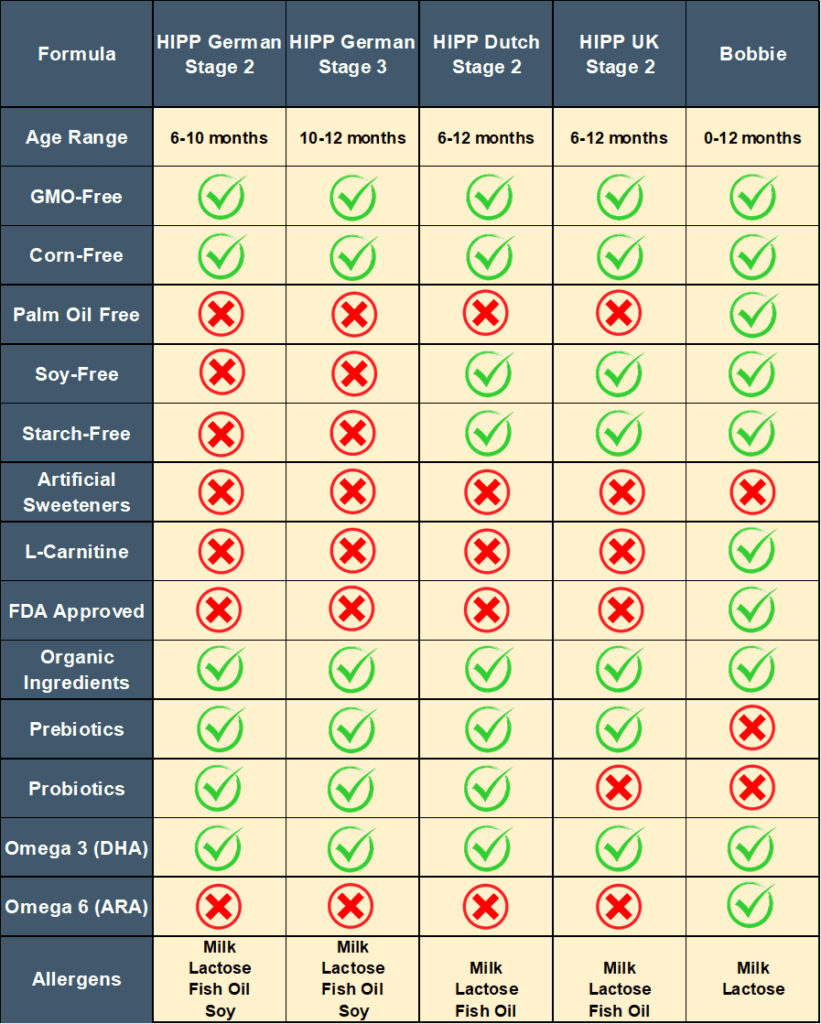
When comparing Bobbie and HiPP (6-12 months) formulas, several important distinctions become evident:
Bobbie:
- Bobbie offers a range of formulas that are GMO-free, corn-free, starch-free, palm oil-free, and soy-free. This makes it a suitable choice for parents seeking formulas without these specific ingredients.
- It includes L-carnitine for the whole first year, which can play a role in energy metabolism.
- Bobbie’s formulas are made with organic ingredients that are EU organic certified, reflecting a commitment to high-quality sourcing and environmentally friendly practices.
- While it doesn’t contain prebiotics or probiotics, it does provide DHA/ARA for infant brain and eye development.
- Bobbie’s formulas meet FDA requirements, making them compliant with U.S. regulatory standards.
HiPP (6-12 months):
- HiPP formulas for this age group are GMO-free and soy-free (except for the German version with emulsifier lecithins). This makes them suitable for parents looking for cleaner and allergen-friendly options.
- They are typically starch-free, although the German version includes lactose and starch as carbohydrate sources.
- HiPP incorporates organic ingredients that are EU organic certified, emphasizing a commitment to high-quality, organic sourcing.
- These formulas include prebiotics and probiotics (except for the UK version), which can support digestive health and a healthy gut microbiome.
- HiPP provides DHA for infant brain and eye development, but it does not contain ARA.
- HiPP formulas may not meet FDA requirements, so they may be more commonly found in European markets.
Ingredients Comparison (6-12 months):
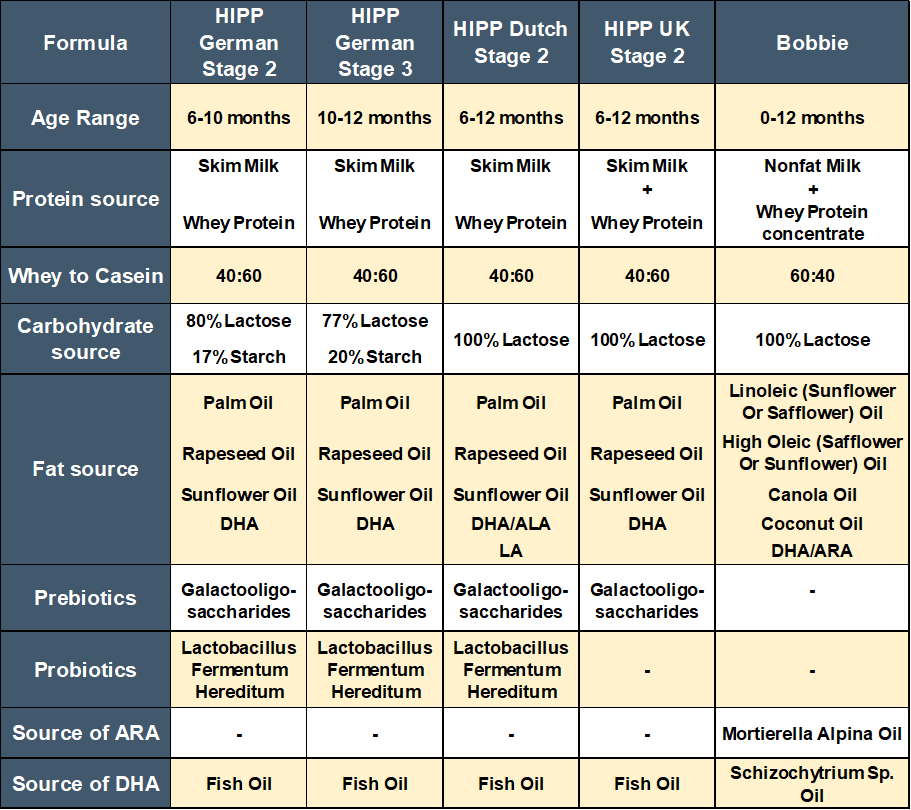
Protein Source:
When comparing Bobbie and HiPP (6-12 months) formulas in terms of protein, both formulas utilize a combination of skim milk (nonfat milk) and whey protein as their primary protein sources. However, a notable difference lies in the whey-to-casein ratio:
Bobbie:
- Bobbie’s formula maintains a whey-to-casein ratio of 60:40, which means it contains a higher proportion of whey protein compared to casein.
- A higher whey content can be beneficial as it closely mimics the protein composition of breast milk, making it easier for many infants to digest.
HiPP (6-12 months):
- HiPP Stage 2 formulas, in contrast, have a whey-to-casein ratio of 40:60. This indicates a higher proportion of casein compared to whey.
- While casein-dominant formulas can provide longer-lasting satiety for some infants, they may not replicate the protein composition of breast milk as closely as formulas with a higher whey content.
Carbohydrate Source:
When comparing Bobbie and HiPP Stage 2 formulas in terms of carbohydrate sources, they share a common primary carbohydrate source, which is organic lactose. Lactose is a natural sugar found in breast milk and is generally well-tolerated by most infants, providing a source of energy and aiding in calcium absorption.
However, it’s important to note that the German version of HiPP Stage 2 formulas differs from the others in that it contains both lactose and starch as carbohydrate sources. The addition of starch may provide additional energy but deviates from the pure lactose composition found in breast milk or in the non-German versions of these formulas.
Fat Source:
Bobbie:
- Bobbie formulas use a blend of organic oils, including high oleic safflower or sunflower oil, linoleic safflower or sunflower oil, canola oil, and coconut oil.
- This blend of oils provides a diverse range of fatty acids and offers a mix of nutrients, contributing to a well-rounded fat profile in the formula.
HiPP (6-12 months):
- HiPP formulas in this age range typically contain a combination of organic palm oil, rapeseed oil, and sunflower oil as their primary fat sources.
- While these oils are organic, it’s worth noting that some parents have concerns about the environmental and health implications of palm oil production.
Nutrient Comparison (6-12 months):
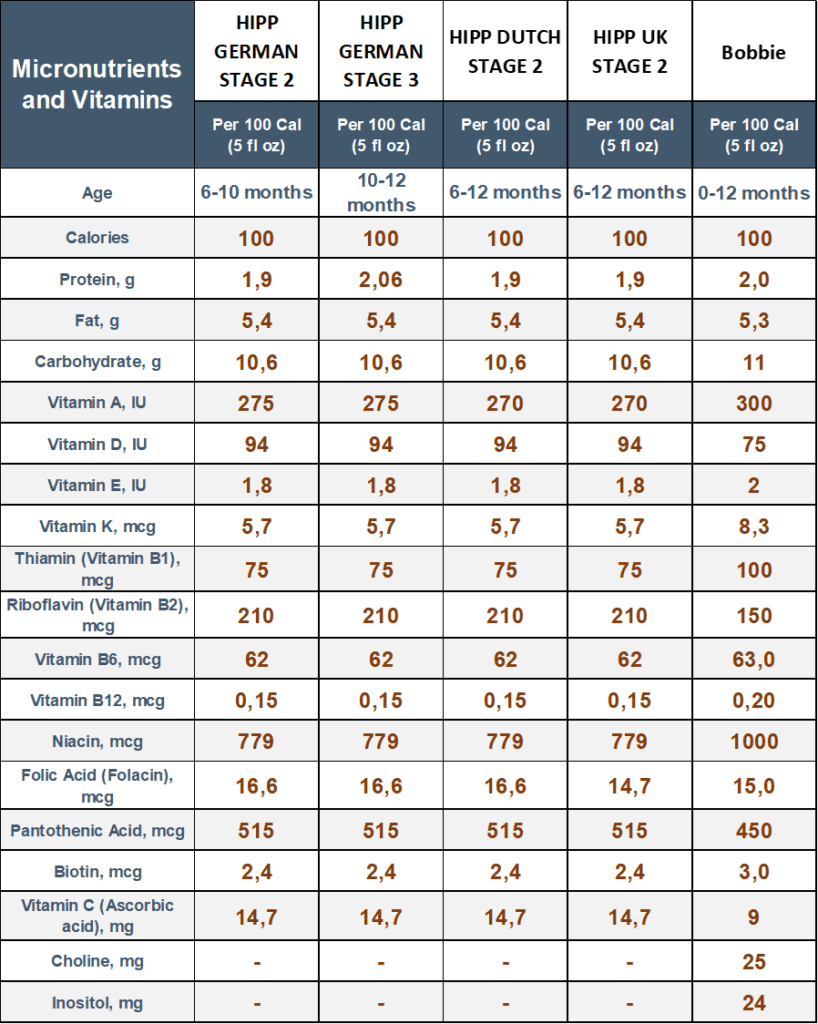
Micronutrients:
When comparing Bobbie and HiPP Stage 2 formulas in terms of micronutrients, it’s important to note that the differences in macronutrient content (higher protein and carbohydrate levels in Bobbie, and slightly more fat in HiPP) do not significantly impact the overall micronutrient profile. Both formulas are designed to provide comprehensive nutrition for infants during the first six months of life.
Vitamins:
When comparing Bobbie and HiPP Stage 2 formulas in terms of vitamins, it’s evident that each formula has its unique vitamin profile:
Bobbie:
- Bobbie formulas contain higher levels of vitamin A, vitamin E, vitamin K, vitamin B1, vitamin B6, vitamin B12, niacin, biotin, choline, and inositol. These vitamins play essential roles in various aspects of infant development and overall health.
HiPP Stage 2:
- HiPP Stage 2 formulas have higher levels of vitamin D, vitamin B2, folic acid, vitamin C, and pantothenic acid. These vitamins are important for bone health, metabolic processes, immune support, and overall growth.
It’s worth noting that HiPP Stage 2 formulas do not contain choline and inositol, which are found in Bobbie. Choline and inositol are essential for brain development and various metabolic functions.
Related: HiPP Combiotic VS Gerber Good Start Gentle: Which One to Choose?
Minerals:
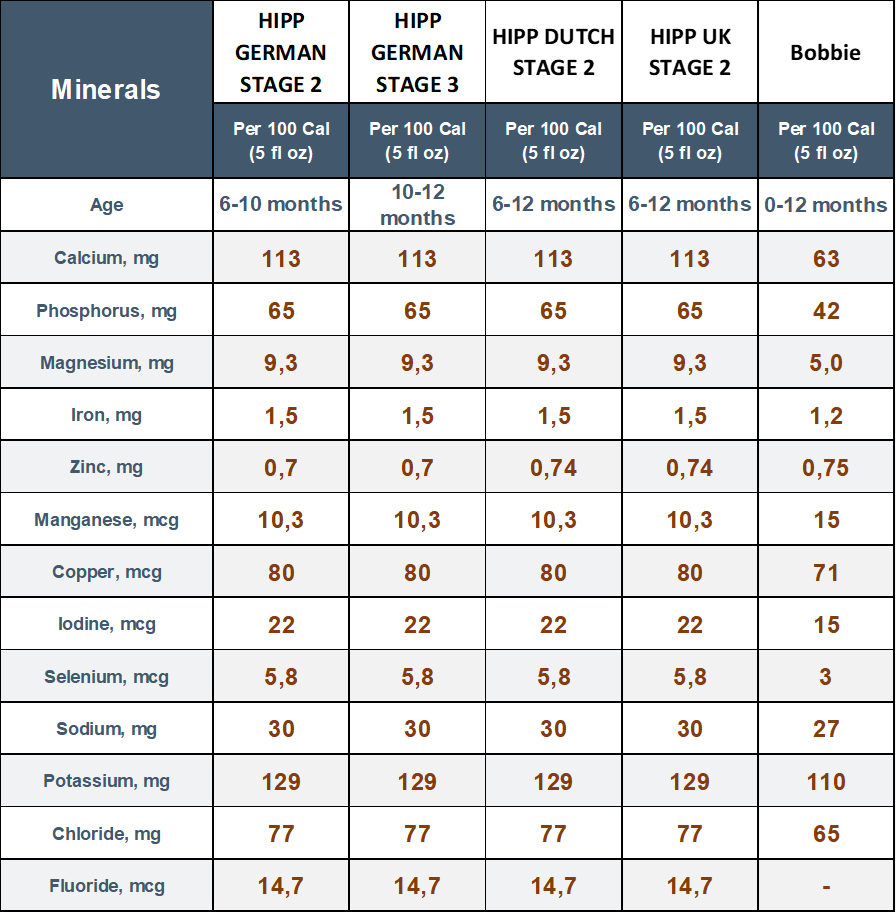
When comparing Bobbie and HiPP Stage 2 formulas in terms of minerals, it’s evident that each formula has a distinct mineral profile:
Bobbie:
- Bobbie formulas have higher levels of zinc and manganese, both of which are essential minerals for infant growth, immune function, and overall metabolic processes.
HiPP Stage 2:
- HiPP Stage 2 formulas contain higher levels of several minerals, including calcium, phosphorus, magnesium, iron, copper, iodine, sodium, selenium, potassium, and chloride. These minerals play crucial roles in bone and teeth development, nerve function, electrolyte balance, and overall body function.
Notably, HiPP Stage 2 formulas also include fluoride, which can support dental health, but it’s generally not present in infant formulas due to concerns about potential overdose.
Price Comparison (6-12 months):
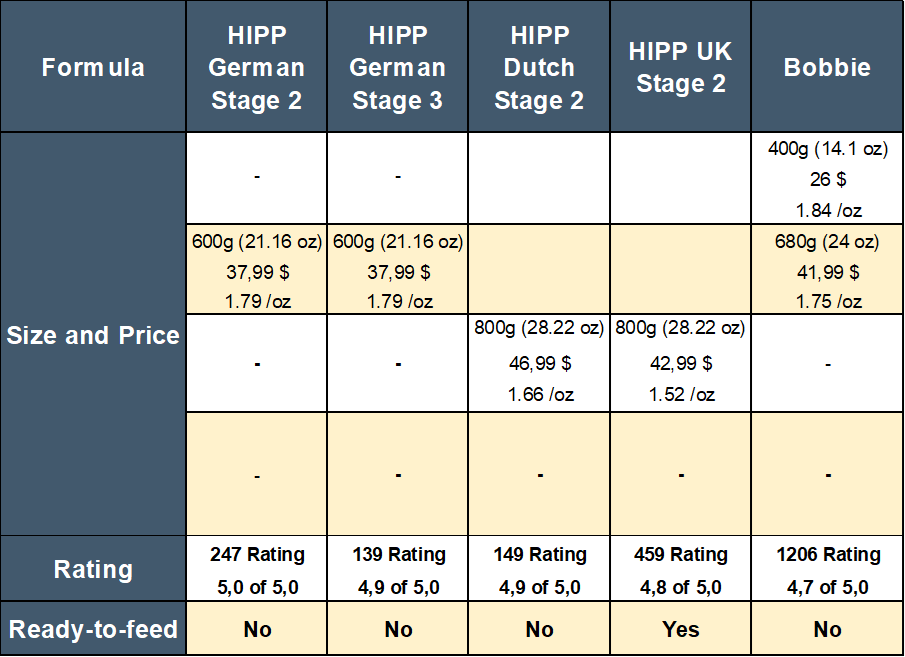
Regarding sizes and prices, they are the same as for 0-6 months except that HiPP Stage 2 German doesn’t have a liquid version.
Where to Buy?
| Formula | Where to Buy |
|---|---|
| HiPP German Stage 2 | Buy HERE |
| HiPP German Stage 3 | Buy HERE |
| HiPP Dutch Stage 2 | Buy HERE |
| HiPP UK Stage 2 | Buy HERE |
| Bobbie 14.1 oz | Buy HERE |
The Best One?
The choice between Bobbie and HiPP ultimately depends on a combination of factors, including individual preferences, priorities, and the specific nutritional needs of the baby.
Bobbie offers several advantages. It is palm oil-free, meeting the preferences of parents concerned about the environmental and health implications of palm oil. It also complies with FDA requirements, providing assurance of quality and safety for parents in the United States. The availability of Bobbie in local U.S. stores can be convenient for many families. Additionally, Bobbie’s enrichment with vitamins can be appealing, as these nutrients are crucial for infant development.
HiPP, on the other hand, is an established brand known for its quality and commitment to organic ingredients. The inclusion of prebiotics and probiotics can support a healthy gut microbiome in infants, and HiPP’s mineral enrichment ensures comprehensive nutrition. HiPP’s long history and reputation as a trusted brand may also resonate with parents seeking time-tested options.
Ultimately, the choice between Bobbie and HiPP depends on personal priorities and values. Parents who prioritize palm oil-free formulas, FDA compliance, and vitamin enrichment may lean towards Bobbie. On the other hand, parents who value prebiotics, probiotics, and mineral enrichment may favor HiPP.
